For growing businesses, offering customer success at scale can pose a real challenge. At Intercom, we found ourselves in exactly this position and it started to cost us in terms of becoming outnumbered and dropping the ball with our customers.
In this article, I’ll explain our journey, how we came to the decision to start scaling our approach and why, and how we transitioned our CS org from ‘support on steroids’ to a strategic partner in the business using living resources, scalable content, and a targeted and proactive approach.
My name is Matt O'Boyle, I'm a Customer Success Manager here at Intercom in Dublin. I've been a customer success manager with Intercom for two years now.
Before I was working for Intercom I was a customer of Intercom in a business called Bizimply, another B2B SaaS product based in Dublin, where I was a customer success manager.
Before that, I was doing key account sales for Bizimply, and before Bizimply, I was in SAP doing commercial sales there as the only UK and Ireland rep for SuccessFactors.
Prior to getting into the world of B2B SaaS, I was in Student Union politics, I was a student union president at Maynooth University in Kildare.
Funny old journey to get to where I am, but I'm happy to be sharing this article about having customer success at scale.
Customer success at scale
This has been a really trendy topic over the last year in particular, especially with everything that went on in 2020.
People's resources were a bit more strapped, people wanted to make sure they were getting touchpoints on all of their accounts, and giving that personal level of customer success to all their customers at a scaled motion, maybe with smaller teams, maybe with more restricted assets.
When you're considering doing customer success at scale, these are the very typical things that come up.
Who's going to run this in the business?
- Who's actually going to go out there, develop the content, develop the strategy and get all that done?
- What happens if we poke the bear?
For those who aren't familiar with this phrase, everyone has dormant customers, everyone has customers who have not been super engaged, maybe customers who don't even realize they're a customer of yours anymore.
If you reach out to them and try and engage them, does that get them to churn? Does that awaken the bear and get them to leave?
Other things like:
- Would our customers even want this?
- Do they want a scalable motion?
- Shouldn't we just focus on key accounts, taking care of the big fish in our book, as opposed to trying to take care of absolutely everybody?
- Is it counterproductive? And
- How does it affect the customer experience or improve the customer experience?
Most importantly:
- How does it improve the bottom line at the end of the day?
Don't worry, I'll be covering all of that throughout this article.
The agenda
First, I'm going to discuss how Intercom came to the decision last year that we need to start doing customer success at scale and the journey that we've gotten to until that point.
I'm going to talk about where we were, where we are now with scaling our approach, and where we're going to go this year in scaling our approach.
How we came to the decision to start scaling our approach
Where we were
Let's take it right back, a very familiar structure here I think for B2B SaaS companies.
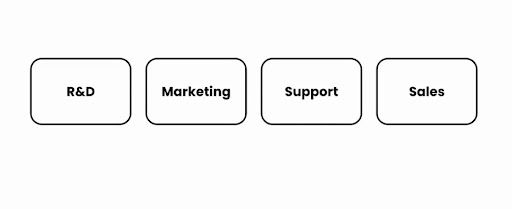
Typically four pillars, we have R&D, marketing, support, and we have sales.
Where does success sit?
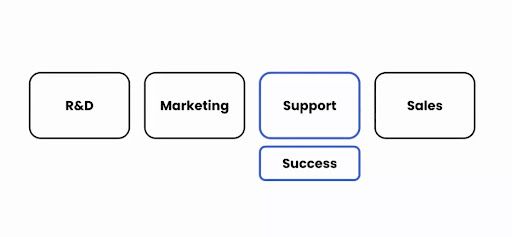
We used to sit in the support realm of things.
Where are we in the support team?
It kind of started off as the sales team looking for help, more tailored help their accounts, you've probably heard it before where there's a deal and someone needs some technical resources, someone needs some help, someone needs some strategy.
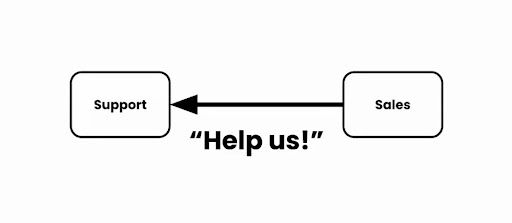
So let's called the support team, get someone on a call, and get a success manager there speaking with the customer. Which kind of led us to be ‘support on steroids’ more than anything else.
Support on steroids
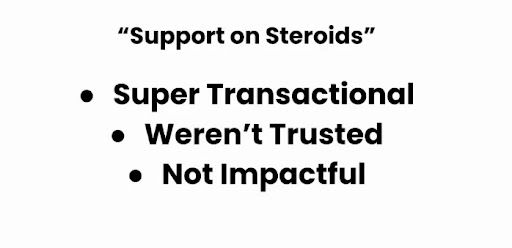
What I mean by that is we were super transactional, you're jumping on calls from time to time, not really developing any relationship with the customer, we weren't really trusted by the customer.
There's also a lot to be said, as to were you trusted by the sales team as well when you're involved in this kind of thing.
Are you impactful? If you're just jumping on and off calls with customers, is it all that impactful at the end of the day? Are you maintaining a long relationship with them? Are these one and once-off calls going to lead to a long-term relationship with you and the customer, a long-term partnership between your business and that customer?
Is this how we want to work?
So our first dilemma was, is this really how we want to work in success at Intercom? The answer is no. We don't want to be transactional. We don't want to be low impact. We want to have a more strategic partnership with the sales team and with our customers.
Strategic partners
That's exactly what we did. We became strategic partners with the sales team, we linked up our existing business relationship managers with customer success managers, so they share their book of accounts, they build strategies together, they jump on calls together, and they have long-term relationships with partners and customers together.
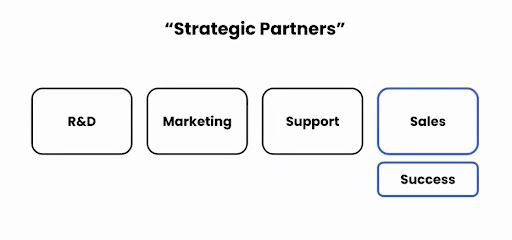
Our own org
While we still consider ourselves our own organization in the business, we are strategic partners with sales, we sit on the sales floor, and we support sales extremely heavily.
It basically meant we went from being on the left-hand side, super transactional, not very trustworthy, not very impactful to being a team that has a long term focus with customers, lots of trust of both customers and the sales team, and then having a massive impact as well on both our customers’ lives and our own.
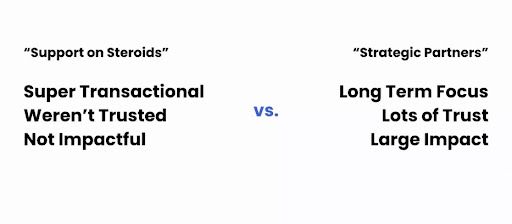
Where are we in 2021?
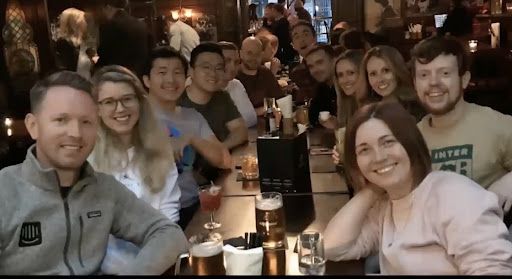
We're a much bigger team, although we look a little bit more like this at the moment, which I think everyone's in the same boat.
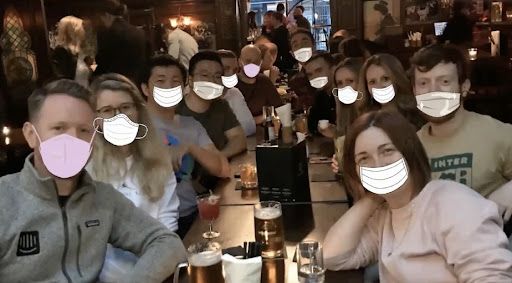
This photo was taken before this dark time.
But we're now officially in the sales organization, we went from a small team of two to 10 CSMs. You can see we're growing out and we're really having that big motion now with customers.
We're working on over 90% of the top deals and renewals that happen in Intercom.
We're also strategic partners with the R&D team, because at the end of the day, who hears more product feedback than your customer success managers, and who was the closest relationship and trust with customers? It should be the customer success team.
Some of the great customers I've gotten to work with over the last two years at Intercom on the large side of things and the more enterprise side of the business.

Where are we going next?
Customer success at scale
I'm moving away from those enterprise accounts as in 2020, we realized we needed to go for customer success at scale for our smaller business segments.
Similarly, just in case you don't have the same structure, breaking up our total customer base into the enterprise, mid-market, and small business accounts.
We had a lot of small business accounts who weren't always small businesses, these were our bread and butter not so long ago, a couple of years ago at Intercom. These were very key customers for us and now as we move more up and to the right, these are falling into the small business section.
But how do we offer a really good experience for them? How do we really take care of them? The answer is to do customer success at scale.
The problems we were facing
Here are some of the problems we faced with customer success at scale.
Becoming outnumbered in the SB segment
We were outnumbered in the SB segments, we had 500 plus premium accounts, there were sales-owned annual accounts that should be receiving some degree of a CSM service.
Intercom’s customer base is only getting bigger
Intercom's customer base, like I said, is only getting bigger, we're growing as a company, which is absolutely fantastic, exactly what you want.
But at the same time, that small business segment is becoming quite hefty as well. They need to be taken care of.
Where do we focus our time?
Where do we focus our time is a big question and that's probably the most important question that you need to ask yourselves when doing customer success at scale.
How do we split up our time? How do we make sure that we're still making sense in where we divvy out our hours?
Some customers barely heard from us - churning without foresight
Some customers barely heard from us, which led to customers churning without any foresight.
This is one of the most heartbreaking emails to get for a salesperson, or for a CSM to see a customer say, "Hey, we need an X, Y, and Z functionality. We're leaving your tool to use a different tool for this because they had that functionality".
And you're sitting there thinking we can do that, we actually have that ability. You guys just didn't know about it. We haven't been in touch with you enough, we haven't been engaged with you enough, and we haven't been supporting you guys and giving you content proactively enough for you to have known that, and now you've left.
Then we've lost a customer. That's a massive issue that the scaled motion is meant to cover.
Customers weren’t using the product to the full extent - fewer avenues for help
Customers weren't using the product to the full extent of course, and customers had fewer avenues for help.
The smaller customers didn't have as much time with them one-to-one CSMs, they didn't have super quick support response times based on who they were in the business.
It gets very tricky, especially over 2020 when everyone's resources are strapped. Everyone has a high volume inbox so it's tricky to get back to everyone.
How do we offer support proactively and make sure people are taken care of in this instance? Of course, it's effective onboarding, adoption, and expansion opportunities for our salespeople.



